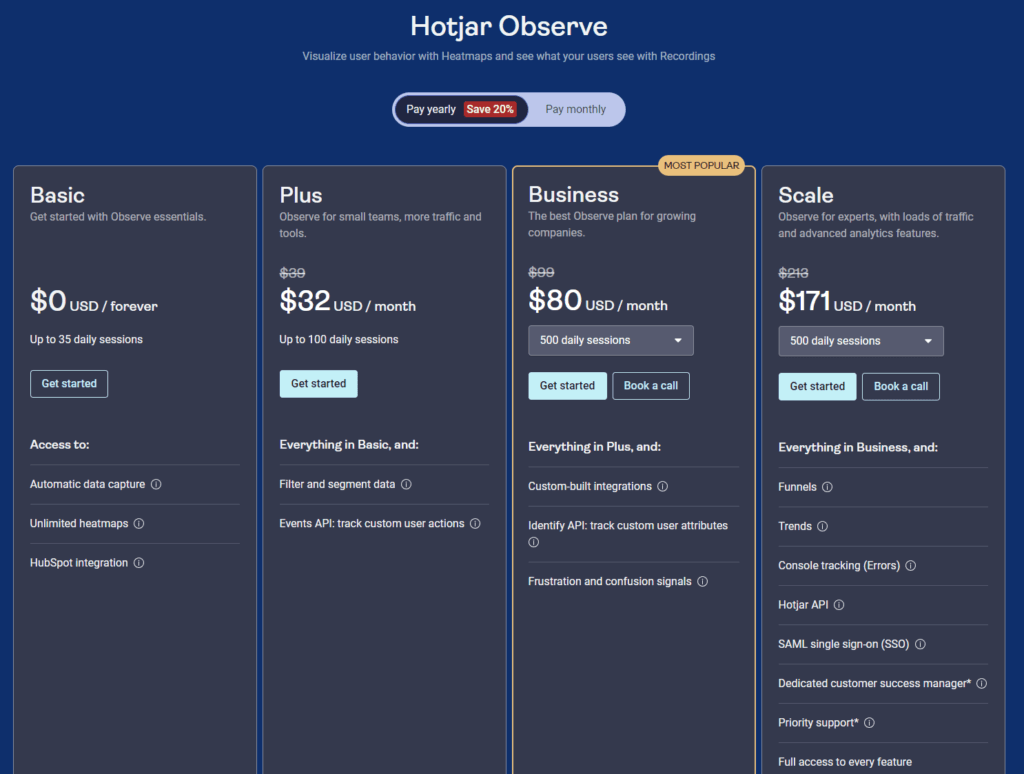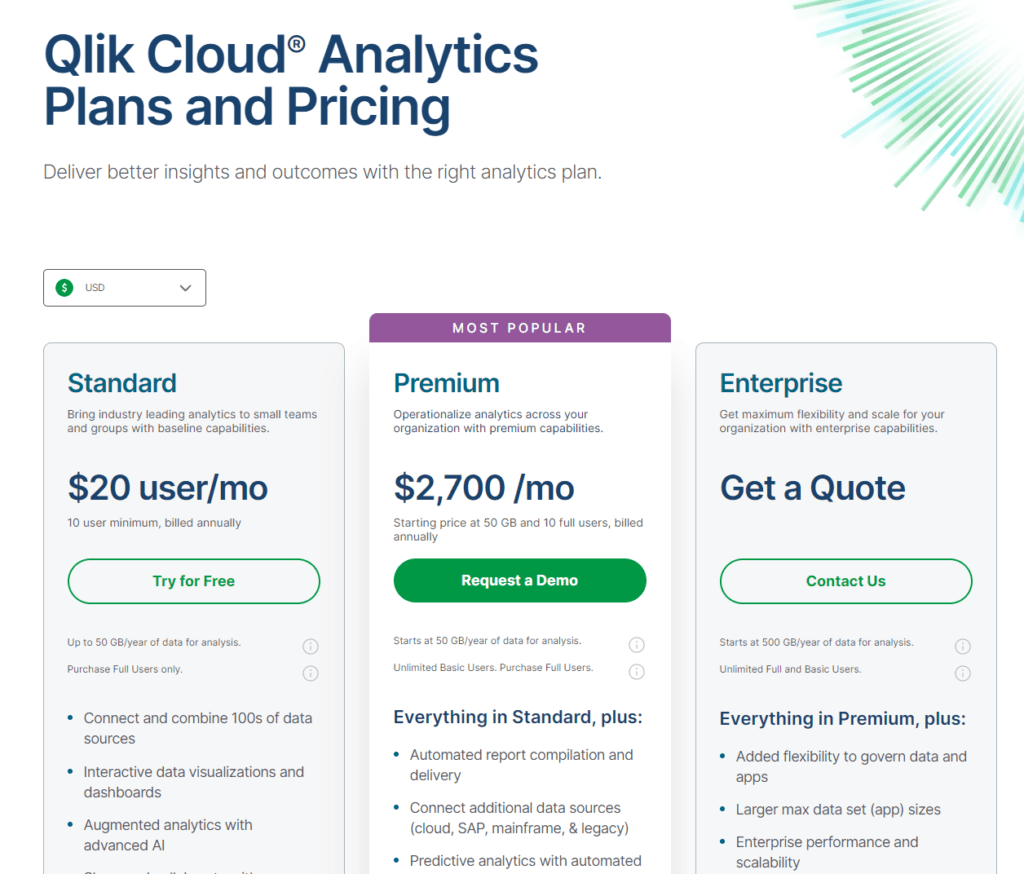In the bustling digital marketplace, choosing the right analytics tool can feel like finding a needle in a haystack. Enter Hotjar and QlikView, two contenders that stand out, but for very different reasons. Hotjar, with its user-friendly interface, offers direct insights into how users interact with your website. QlikView, on the other hand, dives deep into business intelligence, helping you make data-driven decisions across your company. If you’re at the crossroads trying to decide which path to take, you’re in the right place. Let’s delve into the core of these tools and discover which one aligns with your needs.
| Hotjar | QlikView |
|---|---|
 |  |
| G2 Score – 4.3 out of 5 stars | G2 Score – 4.1 out of 5 stars |
| TrustRadius Score – 8.2/10 | TrustRadius Score – 8/10 |
Understanding User Behavior vs. Deep Data Analysis
Hotjar: The User Experience Magnifier
Hotjar illuminates the user experience on websites with a clarity that brings the often invisible journey of the user into the spotlight. It specializes in capturing the nuanced interactions users have with a website, offering visual tools like heatmaps and session recordings that make understanding user behavior not just insightful but also intuitively accessible. These tools allow businesses to see through the eyes of their visitors, identifying what draws their attention, where they encounter friction, and how they navigate through the digital space. This immediate, visual feedback is pivotal for optimizing web pages, improving user interfaces, and enhancing overall user satisfaction.
Moreover, Hotjar’s emphasis on direct feedback from users through polls and surveys adds another layer of depth to its user behavior analytics. This direct line to the visitor’s thoughts and preferences offers qualitative insights that quantitative data alone cannot provide. By understanding the ‘why’ behind user actions, businesses can make informed decisions that are deeply aligned with user needs and expectations. This user-centric approach to analytics makes Hotjar a powerful tool for businesses focused on enhancing the digital experience and fostering engagement on their websites.
QlikView: The Business Intelligence Powerhouse
Transitioning to QlikView, we enter a domain where analytics extend beyond the surface interactions into the very core of business operations and strategy. QlikView doesn’t just analyze data; it transforms it into a comprehensive narrative that informs decision-making across an organization. Its strength lies in its ability to handle complex datasets from various sources, integrating them into a unified analytical framework. With QlikView, data isn’t just presented; it’s explored in depth, thanks to the platform’s associative data modeling. This approach allows users to uncover hidden trends and patterns, revealing insights that can pivot business strategies and drive innovation.
QlikView’s customizable dashboards and reports serve as a command center for data-driven decision-making, offering a level of depth and sophistication in analysis that caters to the nuanced needs of enterprises. The platform’s capacity for deep data analysis extends to predictive analytics, scenario modeling, and performance monitoring, ensuring that businesses are not only reacting to the present but also anticipating the future. This comprehensive approach to business intelligence makes QlikView an invaluable asset for organizations aiming to leverage data across all facets of their operations, from marketing and sales to finance and supply chain management.
Customization and Flexibility
Tailoring Your Analytics Experience
Hotjar: User-Centric Customization
Hotjar positions itself as an exceptionally user-friendly tool, primarily catering to those looking to enhance the user experience on their websites. Its flexibility shines through in the way it allows users to configure various aspects of data collection and analysis. For instance, heatmaps can be set up for specific pages or user actions, capturing the most relevant interactions to inform design and content strategy. Similarly, feedback tools can be customized extensively, from the questions asked to the timing and placement of surveys on the site, ensuring businesses gather actionable insights directly from their audience.
This level of customization in Hotjar is designed not to overwhelm but to empower users with the right tools to understand and improve the user journey. The platform’s intuitive interface ensures that these customization options enhance the user experience rather than complicate it. This approach makes Hotjar an accessible yet powerful ally for businesses of all sizes, providing them with the flexibility to tailor the tool to their specific needs without requiring deep technical expertise.
QlikView: Deep Customization for Comprehensive Analysis
On the flip side, QlikView offers a different kind of customization and flexibility, one that dives deep into the heart of business intelligence. It provides users with the capability to create highly customized dashboards and reports, integrating data from an array of sources to paint a comprehensive picture of business performance. The level of customization available in QlikView is expansive, allowing for the creation of complex data models and visualizations that can reveal insights hidden in vast data sets.
The flexibility of QlikView extends beyond just dashboard customization. Its associative data modeling enables users to explore data connections freely, uncovering insights that rigid data analysis tools might miss. This approach empowers users to follow their intuition, asking questions and exploring data in a dynamic, non-linear fashion. For organizations with complex data analysis needs, QlikView’s flexibility offers the ability to tailor the analytics process to match their unique business questions, making it a powerful tool for data-driven decision-making.

Related: Check out our free SEO suite

Integration and Ecosystem Compatibility
Ensuring Seamless Connectivity
Hotjar: Effortless Integration for Immediate Insights
Hotjar is designed to be as user-friendly and accessible as possible, which extends to its integration capabilities. Recognizing that its primary users—marketers, product managers, and UX designers—may not always have extensive technical resources at their disposal, Hotjar ensures that integrating its tool into your website or e-commerce platform is a straightforward process. By simply copying and pasting a snippet of code, businesses can start collecting valuable insights into user behavior without needing a deep dive into complex integration processes.
This simplicity in integration doesn’t mean Hotjar operates in isolation. It’s designed to complement and enhance the data collected by other tools in your marketing and analytics stack, such as Google Analytics. By bridging qualitative insights with the quantitative data from these other sources, Hotjar provides a more comprehensive view of user experience and behavior. Furthermore, its compatibility with a variety of platforms—from WordPress to Shopify—ensures that whether you’re running a content-heavy blog or a bustling online store, Hotjar fits seamlessly into your site, enhancing your ability to gather user insights without disrupting existing operations.
QlikView: Comprehensive Integration for In-depth Analysis
On the other end of the spectrum, QlikView caters to organizations with complex data analysis needs, offering robust integration capabilities that allow businesses to consolidate and analyze data from across their digital ecosystem. QlikView shines in environments where data is sprawled across various systems and platforms, providing the tools necessary to bring this data together for comprehensive analysis. Its ability to connect with a vast array of data sources, including ERP and CRM systems, cloud services, and databases, makes it an invaluable tool for businesses seeking a 360-degree view of their operations.
QlikView’s approach to integration extends beyond simple data aggregation. The platform’s powerful data modeling capabilities allow businesses to transform and enrich their data as it’s brought into the system, ensuring that the insights generated are both relevant and actionable. For organizations that rely on a diverse set of software solutions to manage their operations, QlikView’s flexibility in integration means that it can adapt to your existing tech stack, minimizing disruptions to workflows while maximizing the value of your collected data.
Data Security and Compliance
Safeguarding Your Insights
Hotjar: Prioritizing User Data Protection
Hotjar places a high emphasis on user data protection, implementing robust security measures to ensure the privacy and integrity of the data it collects. Recognizing the sensitivity of user behavior data, Hotjar adheres to GDPR guidelines and other global privacy standards, ensuring that businesses using its platform can comply with these regulations effectively. This is crucial for businesses operating in or catering to customers in regions with strict data protection laws.
Furthermore, Hotjar provides tools and settings that allow businesses to control what data is collected, ensuring that personally identifiable information (PII) can be excluded from session recordings and heatmaps. This level of control is vital for maintaining user trust and ensuring compliance with privacy regulations. Hotjar’s commitment to data security and privacy extends to its transparent communication about data handling practices, providing businesses and their users peace of mind regarding the safety of their information.
QlikView: Ensuring Enterprise-Grade Security
QlikView, tailored more towards enterprise-level data analytics, offers comprehensive data security measures designed to meet the rigorous requirements of large organizations. It provides extensive control over data access and permissions, ensuring that sensitive business information is only accessible to authorized users. This granular access control is particularly important for businesses dealing with proprietary or confidential data across various departments.
In addition to access controls, QlikView supports data encryption both at rest and in transit, safeguarding data integrity and preventing unauthorized interception. For businesses concerned with regulatory compliance, QlikView’s compliance with global data protection standards, including GDPR, HIPAA, and others, ensures that they can leverage powerful analytics capabilities without compromising on security or compliance.
Pricing and Value for Money
Maximizing Your Analytics Investment
Hotjar: Accessibility Meets Affordability

Hotjar is renowned for its straightforward pricing structure, designed to accommodate businesses at various stages—from startups to large enterprises. Offering a basic free plan, Hotjar makes it possible for smaller sites or those just beginning their analytics journey to start gathering valuable user insights with no upfront cost. As businesses grow and their needs become more complex, Hotjar offers several tiered pricing options that scale with your requirements.
What stands out about Hotjar’s pricing is not just its accessibility but also the clear value it provides at each level. Even at the lower-priced tiers, users gain access to a suite of powerful tools for understanding user behavior, including heatmaps, session recordings, and feedback polls. This makes Hotjar an attractive option for businesses looking to maximize their investment in user experience insights without breaking the bank.
QlikView: Tailored Solutions for Comprehensive Analysis

QlikView operates on a different pricing model, one that’s tailored to meet the needs of businesses seeking deep, comprehensive analytics capabilities. As a platform that caters more to enterprise-level data analysis, QlikView’s pricing reflects the sophistication and breadth of insights it provides. Businesses interested in QlikView typically engage in a consultation process to determine the best configuration of services and the associated costs.
This tailored approach ensures that businesses only pay for the analytics capabilities they need, but it also means that the investment in QlikView can be significant, especially for smaller businesses or those with limited analytics budgets. However, for organizations that require advanced data integration, associative analytics, and customizable dashboards at an enterprise scale, the value offered by QlikView in terms of deep insights and informed decision-making can justify the investment.
Conclusion
Hotjar shines as a beacon for businesses keen on understanding and enhancing the user experience on their websites. Its intuitive tools for visualizing user interactions, combined with direct feedback capabilities, make it an essential asset for those aiming to optimize web pages and engage more effectively with their audience. Hotjar demystifies user behavior, making it accessible and actionable for businesses of all sizes, ensuring that every decision is informed by direct insights into how users interact with their digital presence.
QlikView, on the other hand, serves as a powerful command center for organizations that delve into the depths of their data to inform broad, strategic decisions. With its robust business intelligence capabilities, QlikView enables the integration and analysis of complex datasets, offering a comprehensive view of an organization’s operations. Its sophisticated analytical tools empower businesses to uncover hidden patterns, predict trends, and model scenarios, ensuring that every strategy is backed by a deep understanding of the data that underpins their industry.
Read Next:





















